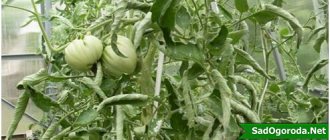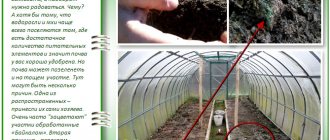Author of the article: Svetlana Galitsina | Updated: 11-01-2022
Hanging folder Stamm
180 ₽ More details
Set of hanging folders Brauberg, Foolscap, 231794, yellow, 80 sheets, 10 pcs.
935 ₽ More details
Serpentines
Very often, vegetable growers are faced with such a problem as the absence of ovaries on eggplants. It happens that plants develop well, bloom profusely, but the fruits do not set, and over time the empty flowers fall off. It is fair to note that this situation most often arises when growing eggplants in a greenhouse. Why does this happen, and what to do about it? Generally speaking, the reason is a violation of agricultural technology. There are several ways to solve this problem, but first you need to determine the reason why there is no ovary, and there are quite a lot of them.
Reasons why eggplants do not set in greenhouses and greenhouses
When growing eggplants in a greenhouse, gardeners are often faced with a complete absence of ovaries. There are a number of reasons for this.
Bad Seeds
When choosing planting material, pay attention to the varieties intended for your climate and region. Hybrids are very popular - they are more resistant to temperature changes and can withstand acclimatization well.
The best greenhouse varieties and hybrids : Behemoth, Alekseevsky, Violet Miracle, Filimon, Bibo hybrid.
Important! Before planting, the seeds are checked. To do this, they are immersed in a glass of lightly salted water for 30 minutes. Good seeds will sink to the bottom, while bad seeds will remain on the surface of the water.
Bad seeds can please you, at best, only with flowering. There will be no fruit. Select only high-quality planting material.
Soil composition
Eggplants need airy, nutritious soil with a neutral acidity level . The presence of nitrogen in it is important. Its deficiency will lead to the absence of ovaries, but its excess can lead to the flowers falling off. The presence of phosphorus and potassium in the soil is mandatory.
Attention! Light and nutritious soils are suitable for eggplant. In clay, acidic, podzolic soil, fruit formation may not occur.
Violating Neighborhood Rules
For comfortable growth and development, eggplant needs suitable neighbors :
- pepper;
- lettuce, spinach, basil;
- legumes – peas, beans;
- Chinese cabbage, onion, radish;
- parsley and dill (they will enrich the soil and repel pests).
Experienced gardeners advise planting each crop in a separate bed. In a greenhouse, it is contraindicated to combine eggplants with cucumbers and tomatoes . The former will shade them, but tomatoes need coolness and shade.
Attempts to plant incompatible crops with eggplants can result in a complete lack of harvest.
Mistakes when watering
Proper watering is a prerequisite for the harmonious development of vegetables . Excess moisture will lead to rotting of the roots, and too little will lead to the falling off of flowers and small fruits. When watering, the soil should be moistened by 20 cm. The plant is watered at the root. Avoid getting it on the sheets - this can lead to the development of fungal diseases.
Important! Do not water the plant with cold water. The optimal temperature is 24-25°C.
Unfavorable temperature conditions
Eggplants produce bountiful fruit when given warmth and sunlight . Pollination occurs at temperatures from 25 to 30°C. The temperature in the greenhouse must be maintained at 26-27°C and not allowed to drop or rise.
Nutritional deficiencies
The lack of fruit may be due to a lack of nutrients in the soil . The vegetable is fed from the moment the seeds are planted, alternating mineral fertilizers with organic ones.
Main reasons
The most common reasons for the ovary not to appear are:
- Exceeding the temperature above 30˚С (it should be remembered that exceeding the air temperature by more than 30 – 32˚С makes the flower sterile);
- Irrational application of fertilizers (lack of boron, phosphorus or calcium or excess nitrogen);
- Rainy and cold weather (night temperatures should not fall below 15˚C);
- Lack of moisture - the plant is a moisture-loving plant, and if there is a lack of moisture, the ovary does not form;
- The soil. These plants will not produce good ovaries and bear fruit in heavy and acidic soil.
- Shading. With a lack of sunlight, the ovary falls off.
Why do eggplants bloom but not set?
Gardeners are familiar with the situation when eggplants grow and bloom well, but the fruits do not set. Weather conditions or violation of care rules may be to blame.
Why don't they bear fruit?:
- Wrong landing site selected. The vegetable grows in the shade, it lacks light and warmth.
- Sudden changes in temperature. The temperature in the greenhouse is too high or too low.
- Poorly fertilized soil. Incorrect feeding or its complete absence.
- Lack of moisture or overwatering of the plant.
- High humidity in a greenhouse. Humid air prevents plants from pollinating. After watering, be sure to ventilate the greenhouse.
- Drafts in the greenhouse. Gusts of cold air prevent the formation of ovaries. For ventilation it is enough to open one window.
- Clogged soil does not allow fruits to develop. After watering, loosen the soil.
- Regularly inspect the bushes for pests: Colorado potato beetle, aphids. If they are infested, you cannot use chemicals to control them - in greenhouse conditions the plant will absorb them.
Selecting a variety by region of Russia
In order not to wonder why eggplants bloom but do not set, and what to do in this situation, you should choose varieties of fruiting plants depending on the climate of the region. For example, “Almaz” is one of the most popular eggplant varieties today. Due to its resistance to variable weather, it gets along well both in southern cities and in Siberia. Getting acquainted with this variety is recommended for beginners who are just delving into the work of a gardener.
The central zone of Russia is not as productive as the southern zone. In that area, the Banana variety is more popular than Epic, Black Beauty and F1. The remaining varieties are not picky and can be grown in any cities and towns with proper care.
Like any other root crop, eggplants can bloom but not set for a variety of reasons. To determine what to do and how to grow fruits, you should carefully read the list of tips and recommendations. It will help you cope with both primary and secondary problems, teaching you how to care for vegetables correctly.
What to do to correct the situation
Don’t be disappointed in advance; try to apply the advice of experienced gardeners.
Feeding
A common cause of barren flowers is a lack of essential nutrients in the soil . During growth, the plant is fed at least four times with nitrogen and potassium-phosphorus fertilizers :
- Two weeks after planting the seedlings in the greenhouse. At this time, the root system became stronger. Nitrogen fertilizers work well.
- With the appearance of the first ovaries. Use complex drugs.
- During fruit formation. Potassium-phosphorus fertilizers would be an ideal option.
- During active fruiting of the crop. Fertilizers with potassium and phosphorus will come in handy.
During the flowering period, gardeners use boric acid as a fertilizer . A few drops are dissolved in 10 liters of water.
Important! Use only root feeding. If the composition gets on the leaves, wash it off with clean water.
Correction of agrotechnical errors
Correct agrotechnical errors, if any as violation of temperature, watering, lighting conditions:
- Check to see if enough sunlight is entering the greenhouse.
- Measure the temperature in the greenhouse.
- Inspect the soil moisture. In cloudy weather, it is better to reduce watering; once every 6-7 days is enough. On hot days, water the plant once every 3-5 days. The water should be warm. Don't let it dry out.
- After watering, ventilate the greenhouse and loosen the soil. Avoid drafts and high humidity.
Secrets of increasing ovary formations
Secrets, the use of which will help in the formation of fruit ovaries:
- Eggplants are self-pollinating, but sometimes they need help . In a greenhouse, due to high humidity, it is difficult for pollen to be transferred to other flowers. It accumulates and sticks together. The pollination process is disrupted. To prevent this, control the humidity and periodically gently shake the branches with flowers to prevent the pollen from drying out.
- Form the bush correctly. Remove bad ovaries and damaged, yellowed leaves. When forming the fruit, remove the remaining corolla of the flower. It rots, which means the fruit itself can rot.
- Use soil mulching . Thanks to mulch (straw, grass, sawdust), uniform moisture is maintained for a long time.
Preventive measures
To help the plant form high-quality and strong ovaries, experts recommend taking a number of preventive measures:
- prepare the soil thoroughly: apply fertilizer, loosen, moisten;
- select only high-quality seed material;
- carry out regular ventilation of the greenhouse;
- carry out regular shaping of the bush: remove dry, dead, weak and damaged stems, poor-quality ovaries, dry leaves;
- systematically shake the pollen on the flowers to increase the percentage of pollination.
Eggplants, although they are a whimsical and capricious plant, with proper adherence to agricultural technology and the organization of comfortable conditions, can please gardeners with stable and abundant harvests. The main thing is to remember that the culture requires nutritious soil, stable moisture, high-quality fertilizing and regular human care.
How to prevent the problem from occurring
It is better to prevent the problem of lack of ovaries in advance:
- Take care of the soil for the plant. It must be nutritious. Fertilize with phosphorus-potassium solutions in the fall. Do not plant eggplants in cold soil - this will slow down their development. The soil must contain sufficient nitrogen. Its deficiency will lead to the absence of ovaries, and its excess will only give growth to the bush. Wood ash will help reduce nitrogen levels.
- Think in advance about where to plant the crop. It should be well lit by sunlight.
- Use high-quality zoned varieties.
- Plant with seedling material. Plant the seeds in separate pots; when replanting, do not pick up the roots; plant them together with the soil.
- Keep an eye on pollination. If the flowers are not pollinated, carry out this process yourself. Use a brush to transfer pollen from one flower to the pistils of others.
- Maintain crop rotation. Eggplants should not be planted in the place where vegetables from the nightshade family (tomatoes, potatoes, peppers) previously grew.
Extra inflorescences
Ideally, one plant should not have more than 15 fruits. Otherwise, the vegetable will not have enough strength to feed them and fully grow. By shedding flowers, the plant naturally normalizes the amount of future harvest.
If the plant does not want to shed its inflorescences on its own, the gardener will have to help it. In order for each bush to produce large fruits, only the largest buds are left on it, the rest are removed. This also applies to escapes. They are pinched, leaving 3–4 of the strongest ones.
Buds will form faster. When the ovary is formed, the excess flowers are cut off.
Tips and tricks
The advice of summer residents will come in handy when growing eggplants . They recommend:
- Do not plant seedlings in the ground too deep.
- Provide space for plants. To do this, dig holes at a distance of 50 cm.
- After planting, water the plants with potassium permanganate and sprinkle with wood ash.
- Maintain the permissible humidity in the greenhouse (65-70%).
- Promptly replace greenhouse soil with fresh soil from open beds.
- Observe the microclimatic conditions in the greenhouse.
- Remove weeds and plant debris in a timely manner.
- Tie up tall plants and trim off excess shoots.
Large amount of pollen
Eggplants are plants that bear fruit through self-pollination. Moreover, their pollen is so heavy that it can only be transported over a distance of up to a meter. Therefore, to form a normal number of ovaries, you should shake the plants in the morning. Of course, this must be done very carefully.
It is worth considering that even with hand pollination, eggplants can also lose a significant part of their ovaries. This happens due to hot or cold temperatures, since plants are very picky about weather conditions. The optimal temperature for growing eggplants is from 25 C to 35 C. Prolonged rainy weather can also negatively affect the condition of the plants; to avoid this, it is better to grow the crop in a greenhouse. The negative effects of temperature conditions can be reduced by treating with Novosil and Immunodeficiency drugs.











